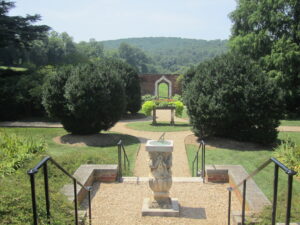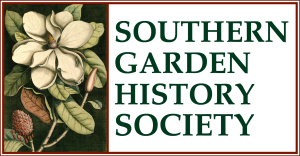
Credit: By Billy Hathorn – Own work, CC BY 3.0, https://commons.wikimedia.org/w/index.php?curid=17248342
Twice visited by SGHS, Montpelier was both the plantation home of an American presidential family as well as the early-twentieth-century estate of William and Annie duPont and later their daughter, Marion duPont Scott. Society members first visited this National Trust property during the 1987 Monticello-based annual meeting, experiencing Montpelier then as a full-blown expression of the duPont family’s wealth. In 2005, during the Fredericksburg annual meeting we saw a home changing greatly from eighteen years earlier, reflecting a National Trust decision to remove later additions and return Montpelier to its Madison-era configuration.
Yet another change happened at Montpelier between 1987 and 2005 with the transfer of management of the duPont’s formal garden from the National Trust to the Garden Club of Virginia (GCV). Although this lacked the “smack-in-the-face” impact of the main house transformation, from a landscapes point of view the transition obviously marked an important moment in the history of the Madison-duPont estate. As with GCV sites discussed previously on the Gardens page, the reader is directed to Margaret Page Bemiss’ Historic Virginia Gardens for an finely-honed account of how this unfolded.*
While details about the earliest Madison-period gardens and plants are limited, Bemiss offers a helpful summary of existing documentation. As with other such eighteenth-and early-nineteenth-century southern landscapes, surviving documents show that Montpelier’s gardens produced a wide range of vegetables, fruit, shrubs, and flowers, most being grown in typical rectilinear plots. Examples cited of the latter, to name but several, include snowdrops hyacinths, daffodils, sweet William, peony, and damask rose.**
More evidence exists for the James and Dolly Madison years and offers a picture of a finely articulated terraced garden southwest of their home. The central feature (then and now) was soil elevated into a large horseshoe pattern which was bisected by a box-edged straight-line sloping path. For design guidance and daily gardening direction, evidence suggests the Madisons turned between 1810 and 1824 first to French gardener Charles Bizet and later to Scotland-born Archibald Blair.*** As elsewhere during this period and in the South, enslaved men and women undertook the physical work, including soil-moving laborers with draft animals as well as people who developed specialized gardening capabilities.
Badly deteriorated, this was the garden that the duPont family encountered—and embraced—when they bought Montpelier in 1901. Over coming years, they rehabilitated and enhanced it dramatically to include upper-level parterres, improved walkways, statuary, and brick walls that would ultimately enclose the entire space. Landscape architecture expertise came from Philadelphia practitioner Oglesby Paul and later and to greater extent from Richmond-based Charles Gillette.****
In January 1990 GCV began their formal connection with the now-termed “Annie duPont Formal Garden.” Site assessment and master planning was soon underway as directed by GCV landscape architect Rudy Favretti, a name now familiar to regular readers of this page. In 1992, on-the-grounds work began using Favretti’s plan, his idea being to simplify the duPont garden to ease restoration and maintenance requirements but also to amplify what was seen as its most significant elements. The reader is again directed to Historic Virginia Gardens, along with the Montpelier website (cited below) for detailed discussions of this phase of work. GCV’s commitment to this garden has, of course, continued after this initial and intensive phase of work. This has been evidenced by further improvements under the direction and management of GCV landscape architect and a former SGHS board member, Will Rieley. Conservation of the garden’s famous statuary lions is but one example of GCV’s standout work of the post-Favretti years.
Unfortunately, there are many facets of Montpelier’s landscape history that a Gardens page post can only touch on. During our SGHS 2005 tour, however, members did get a look at archaeology connected to Montpelier’s African American community, crucial work in relation to the National Trust and the Montpelier Foundation’s ability to relate the full story of the Montpelier cultural landscape. As well, mention should be made of the two-hundred acre “Landmark Forest,” which offers a look at an array of old-growth trees, while another important story is duPont-period horse breeding and the popular racing events that continue to this day. When all this is joined to amazing views of the Blue Ridge Mountains it tallies up to Montpelier being one of Virginia’s most visit-worthy sites.
*******************************************************************
*Margaret Page Bemiss, Historic Virginia Gardens: Preservation Work of the Garden Club of Virginia, 1975-2007, “Montpelier,” 126-135.
**For a more comprehensive plans discussion, see: https://www.montpelier.org/a-paradise-of-roses-flowers-at-montpelier/
***https://www.montpelier.org/learn/annie-dupont-formal-garden/
**** https://www.tclf.org/pioneer/oglesby-paul; https://www.tclf.org/charles-freeman-gillette-biography

Leave a Reply